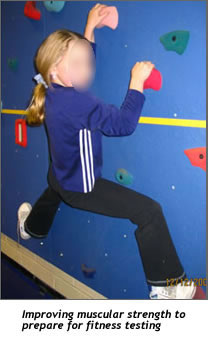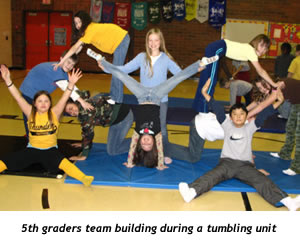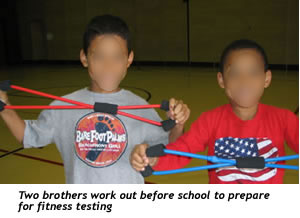Meghan Fauth is a senior at CWU, and is
close to completing her Education major,
with a minor in Reading. She was born
and raised in the lower Yakima Valley,
and hopes to remain in the northwest after
finishing her education. That may be awhile,
as Meghan also plans on completing her
PhD in School Administration.
Harmony's
Fifth Grade Exit Project
by Meghan Fauth
 Healthy
choices are increasingly crucial as
students become more independent. Students
are allowed more choices and more freedom
to make their own decisions as they
reach middle school, high school, college,
and eventually "full-blown-all-on-your-own-adulthood!"
It goes by too quickly as many of us
know, so as teachers, how can we influence
some of the important choices we all
eventually have to make? These include
choices about our health, our eating
habits, and exercise routines, etc.
Sometimes decisions seem so short term:
"Am I going to go to the gym today?"
or "Apple or Snickers bar?"
The truth is these decisions are very
much the opposite. These types of decisions
have long term consequences, and healthy
choices need to be taught early in life
to help create good habits and wise
decision making skills when it comes
to personal health. Healthy
choices are increasingly crucial as
students become more independent. Students
are allowed more choices and more freedom
to make their own decisions as they
reach middle school, high school, college,
and eventually "full-blown-all-on-your-own-adulthood!"
It goes by too quickly as many of us
know, so as teachers, how can we influence
some of the important choices we all
eventually have to make? These include
choices about our health, our eating
habits, and exercise routines, etc.
Sometimes decisions seem so short term:
"Am I going to go to the gym today?"
or "Apple or Snickers bar?"
The truth is these decisions are very
much the opposite. These types of decisions
have long term consequences, and healthy
choices need to be taught early in life
to help create good habits and wise
decision making skills when it comes
to personal health.
Dan Mertz is the Harmony Elementary
Physical Education Specialist and the
Evergreen Elementary Physical Education
Curriculum Coordinator in Vancouver,
Washington. Dan helped create the Exit
Project for fifth graders to help prepare
them for middle school. Due to the project's
huge success, funds were made available
to invite other schools to participate.
So, Alice Atha, the PE Specialist at
Riverview Elementary School in Vancouver,
added the project to her curriculum
last year. Both Dan and Alice presented
on the Exit Project at the WAHPERD State
Conference last fall. Approximately
250 fifth grade students at Harmony
and Riverview Elementary Schools are
involved in the project, and they hope
to have more schools join in soon.
The main goal of the Exit Project is
to help students become acquainted with,
and have respect for, their food choices
and their physical health. The students
are also learning how to apply physical
health and fitness concepts into many
areas of their lives and education.
The project is multi-faceted, and one
that children are required to complete
before they are allowed to move to the
next grade level. The 6 goals the students
work toward include:
1. Be literate
2. Work effectively with others
3. Develop healthy self-esteem
4. Be informed, concerned, and productive
citizens
5. Apply thinking skills
6. Be self-directed learners
The students work towards these goals
by completing all the lessons and activities
required to finish the project. The
Exit Project not only helps the students
reach these goals, but it is student
centered making it relevant and fun.
The students do many activities that
teach important concepts. Here are a
few of the concepts and activities:
- Responsible decision making
- Positive self-talk
- Food-Pyramid and healthy eating
- Reading food labels
- "What is Exercise?"
- Exploring the scientific method
- Making a graph
- Researching and summarizing an article
from the internet
- Writing a bibliography
- Revisiting selected lessons from
the previously taught "Here's
Looking At You 2000" Drug and
Alcohol Awareness program
- Learn the process of scientific
inquiry by choosing a question, completing
research, forming a hypothesis, designing
and performing an investigation, collecting
data, analyzing their findings, and
stating a conclusion about how their
findings apply to their life or other
real world situations.
Some of the students' daily activities
include wearing a pedometer during the
school hours, and logging miles completed
on an excel spreadsheet. The teachers
have individual nutrition plans for
the students to teach about the importance
of movement and healthy eating habits.
Parents have reported about positive
changes at home. Some of these include
the students making healthier food choices
on their own, asking their parents to
make healthier meals and snacks, and
becoming more active in their free time
by choosing physical activity over TV.
The parents have been thrilled with
the results, and are giving very good
feedback to the school.
As you can see, this project requires
students' developing higher level thinking
skills. This really helps prepare them
for standardized tests and the continuation
of education at the college level. When
analyzed with Bloom's
Taxonomy (which categorizes levels
of thinking for students and their assignments)
this project covers all 6 levels. The
levels are (from lowest to highest):
1. Knowledge: memorization
2. Comprehension: summarization
3. Application: using
the skill
4. Analysis: breaking
something down and studying the components
5. Synthesis: merging
2 or more things that don’t seem
related
6. Evaluation: judging
something through a stated or expressed
criteria
 Incorporating
lessons that make use of all 6 levels
helps stretch the student's brains and
challenge their thinking. Incorporating
lessons that make use of all 6 levels
helps stretch the student's brains and
challenge their thinking.
The Exit Project is integrated into
many subjects, such as reading, writing,
math, science, and mental health. All
of the teachers work together to make
the projects meaningful, useful, and
to help them come alive for the students.
The students' daily lives have been
changed as they use this project in
all areas of learning. The fifth graders
begin to understand that they need to
focus on health as a whole. It's not
just physical activity or just good
eating habits. Healthy choices need
to be incorporated into every choice
we make. This project really amplifies
for the students how to make those choices
for themselves.
The following is part of a recent interview
with Dan Mertz about the Exit Project.
What kind of feedback do you get from
parents?
Dan: "Positive
– students want healthy meals
at home."
Do the students enjoy working on their
projects?
Dan: "Yes,
it is real life to them and very hands
on."
Do they present the projects at the
end? If so, how do they do it?
Dan: "We
display projects at our curriculum night."
Do you see any results (immediate or
long term) in the students improving
their wellness?
Dan: "Better
snack choices and more engaged in movement
activities."
How does this project help the students
prepare for life after school (i.e.
citizenship)?
Dan: "Knowledge
on how to live a healthy life."
How has teaching this unit personally
impacted your teaching?
Dan: "I
am supporting the classroom teachers,
and they are supporting me in health
and fitness."
Has there been more group planning
among the teachers of your school?
Dan: "It
has helped me to collaborate more with
classroom teachers, and they in turn
support what I am doing."
How has it affected the teachers at
Harmony Elementary School?
Dan: "Teaming."
Have you made any modifications to
the project?
Dan: "Small
modifications from year to year to make
it better."
How long are you planning on keeping
this project going?
Dan: "As
long as possible. Hopefully we can expand
it to many schools in the district."
What advice
can you give me, as an aspiring teacher
that is interested in doing this in
my classroom?
Dan: "Find
one teacher to team with and others
will follow. This program can be done
easily in every school district. It
can be modified to use with older or
younger students. Health begins at the
beginning of life and doesn’t
ever quite being a part of our lives
until the end. It shouldn’t be
taught separately, it should be incorporated
in to all teaching. The best part is
that you don’t have to be an “athletic”
person to do this project."
For more information please contact:
Dan Mertz, Harmony Elementary School,
dmertz@egreen.wednet.edu
Alice Atha, Riverview Elementary School,
aatha@egreen.wednet.edu
|





